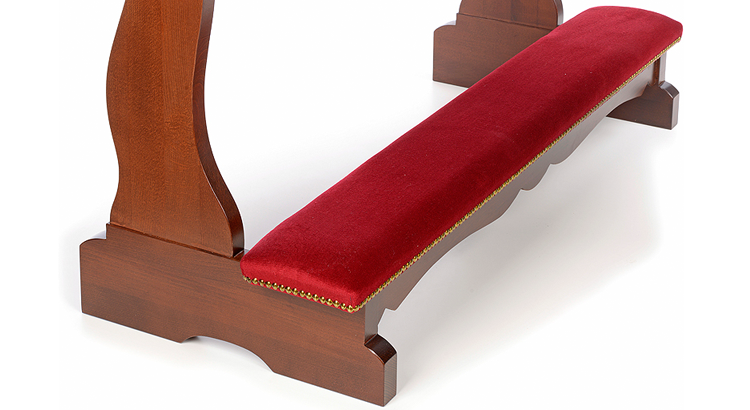Church kneelers, also known as prie-dieus, are an integral part of Christian liturgical furniture, embodying both practicality and profound symbolic significance. These humble pieces of furniture have a storied history, rich with tradition, and have evolved over centuries to reflect changes in religious practices, architectural styles, and cultural influences.
Historical Background
The use of kneelers in Christian worship can be traced back to the early days of the church. Kneeling as a form of prayer and penance is rooted in biblical tradition, with references in both the Old and New Testaments. Early Christians often adopted a posture of kneeling during prayer, reflecting humility and reverence before God. However, dedicated kneelers as furniture pieces began to emerge more prominently during the medieval period.
Medieval Period
In the medieval era, churches and cathedrals saw a significant increase in the use of various liturgical furnishings, including kneelers. These early kneelers were often simple wooden benches or padded cushions placed on the floor. Their primary purpose was to provide a designated space for worshippers to kneel during specific parts of the service, particularly during the Eucharist, confession, and personal prayer.
The design of medieval kneelers was typically straightforward, emphasizing functionality over aesthetics. However, in grand cathedrals and monastic settings, kneelers could be more elaborate, sometimes featuring intricate carvings and decorative elements that mirrored the architectural splendor of the surrounding space.
Renaissance and Baroque Eras
As the Renaissance ushered in a period of artistic flourishing and architectural innovation, church furnishings, including church chair and kneelers, became more ornate. The Baroque period, in particular, saw the emergence of highly decorative kneelers, often crafted from fine woods and adorned with elaborate carvings, gilding, and upholstery. These kneelers were not only functional but also served as symbols of piety and devotion.
During these periods, kneelers often reflected the wealth and status of the church or the individual patron who commissioned them. In some cases, kneelers were personalized with family crests or religious symbols, adding a layer of personal devotion to their use.
The Reformation and its Impact
The Protestant Reformation of the 16th century brought significant changes to church practices and furnishings. Many Protestant denominations emphasized simplicity and austerity in their worship spaces, leading to a decline in the use of elaborate liturgical furniture. In some cases, kneelers were removed entirely as congregations adopted different postures for prayer, such as standing or sitting.
However, in Catholic and Anglican churches, kneelers remained an important feature. The Council of Trent (1545-1563), which aimed to address issues raised by the Reformation, reinforced the significance of traditional practices, including the use of kneelers during prayer and worship.
Modern Era and Contemporary Trends
In the modern era, church architecture and furnishings have continued to evolve, reflecting broader cultural and theological shifts. Contemporary church kneelers come in a variety of designs, from traditional wooden benches with padded cushions to sleek, minimalist styles that complement modern church interiors.
The materials used for kneelers have also diversified. While wood remains a popular choice, modern kneelers may incorporate metal, plastic, or other synthetic materials, offering durability and ease of maintenance. Upholstery options have expanded as well, with a range of fabrics and padding available to enhance comfort for worshippers.
Symbolism and Spiritual Significance
Beyond their practical function, church kneelers carry deep symbolic meaning. Kneeling itself is a powerful gesture of humility, submission, and reverence. It signifies a recognition of God's sovereignty and an acknowledgment of human frailty and need for divine grace. The act of kneeling during prayer is a physical expression of inner devotion and contrition.
In many Christian traditions, kneeling is associated with specific moments of worship, such as during the Eucharist, when receiving communion, or during confession and penance. Kneelers provide a designated space for these acts of devotion, helping to create a sense of sacredness and focus during the liturgy.
The Role of Kneelers in Different Denominations
The use and design of kneelers can vary significantly across different Christian denominations:
- Catholic Church: Kneelers are commonly found in Catholic churches, reflecting the tradition of kneeling during the consecration of the Eucharist and other parts of the Mass. Many Catholic churches have individual kneelers attached to pews, providing worshippers with a convenient way to kneel and stand during the service.
- Anglican/Episcopal Church: Kneelers are also prevalent in Anglican and Episcopal churches, where kneeling is a common posture for prayer and receiving communion. In some cases, kneelers are adorned with needlepoint cushions, often created by members of the congregation as a form of devotional craft.
- Orthodox Church: While kneeling is less common in Orthodox worship, which typically involves standing for long periods, some Orthodox churches do use kneelers during specific parts of the liturgy, such as during the Great Lent or on penitential days.
- Protestant Churches: Practices regarding kneelers vary widely among Protestant denominations. Some, like Lutherans and Methodists, maintain the tradition of kneeling during certain prayers, while others, such as Baptists and Pentecostals, may not use kneelers at all, preferring different postures of worship.
Craftsmanship and Artistic Expression
The creation of church kneelers has often been an opportunity for artistic expression and craftsmanship. In many churches, kneelers are adorned with intricate needlepoint or embroidery, often created by members of the congregation. These handcrafted cushions can feature religious symbols, biblical scenes, or other motifs that enhance the spiritual atmosphere of the worship space.
The woodworking involved in making kneelers can also be highly skilled. Traditional woodworking techniques are employed to create sturdy and aesthetically pleasing kneelers that can withstand years of use. Carvings, inlays, and other decorative elements add a layer of beauty and reverence to these functional pieces of furniture.
The Future of Church Kneelers
As churches continue to adapt to changing societal norms and technological advancements, the design and use of kneelers may continue to evolve. Innovations in materials and ergonomic design could lead to more comfortable and accessible kneelers, ensuring that all worshippers, regardless of physical ability, can participate fully in the liturgy.
Additionally, as churches increasingly focus on sustainability and environmental stewardship, there may be a growing emphasis on using eco-friendly materials and practices in the creation of kneelers. Recycled materials, sustainable wood sources, and non-toxic finishes could become standard in the production of church furnishings.
Church kneelers are symbols of devotion, humility, and the rich history of Christian worship. From their early origins to their modern iterations, kneelers have played a significant role in shaping the physical and spiritual landscape of churches around the world. As they continue to evolve, they remain a tangible expression of the timeless human desire to connect with the divine through acts of prayer and reverence.




